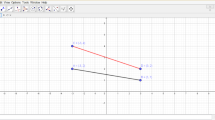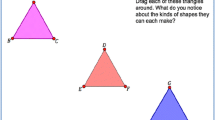Abstract
In this paper, we examine and evaluate several new mathematical representations developed for The Geometer’s Sketchpad v5 (GSP5) from the perspective of their dynamic mathematical and pedagogic utility or expressibility. We claim the primary contributions of Dynamic Geometry’s principle of dynamism to the emerging concept of “Dynamic Mathematics” to be twofold: first, the powerful, temporalized representation of continuity and continuous change (dynamism’s mathematical aspect), and second, the sensory immediacy of direct interaction with mathematical representations (dynamism’s pedagogic aspect). Seen from this perspective, the growth of “Dynamic Mathematics software,” beyond the initial conception of first-generation planar geometry systems, represents a tremendous diversification and expansion of the mathematical domain of the dynamic principle’s applicability (for example, to dynamic statistics, graphing and 3D geometry). But at the same time, this expansion has come at the cost of a decrease in the immediacy of sensory interactions with mathematical representations, as in so-called dynamic graphing, wherein users modify a graph “at a distance” (through slider-based manipulation of the coefficients of its symbolic equation), or in solid geometry tools, in which users’ interactions with represented solids are mediated and distanced by the inevitably-2D communication interfaces of the computer mouse and screen. Thus we focus on this second aspect–sensory interaction with mathematical representations—in evaluating how novel dynamic representations in GSP5 affect mathematical modeling opportunities, student activity and engagement.



Similar content being viewed by others
Notes
The theories of instrumental genesis (see Artigue 2002) do attempt to account for the dual changes of the learner (through instrumentation) and the tool (through instrumentalization)—but tends to de-emphasize the role of mathematics in the interaction.
We follow Sketchpad’s naming practice in referring to these objects as pictures rather than images, since the word image already has a strong geometric meaning (in the context of transformations) unrelated to digital pictures. By picture in this paper we mean the full span of digital images regardless of their format—JPG or GIF or bitmap or vector—or source—digital photos, or generated illustration, or clip art, or found (picture) object on the web.
From a design perspective, this is only half true. The connection to harmonic motion and waveform analysis is intentional from a curriculum perspective—Sketchpad 5’s formulation is the same found in commonly-appearing textbook chapter on “the mathematics of sound,” or in the occasional undergraduate seminar on the same topic. But there are other design rationales favoring an airpressure/time notation over other possible mathematical models of sound. Sound could be made much more accessible in the software if its fundamental expression was by a simple (“volume, pitch”) value pair rather than the more ornate amp × sin(freq × t) expression. However, this simpler representation eliminates various sonic possibilities (for example, the difference between a violin and a piano playing the same note) that can be captured in a richer notation, so concerns of expressivity also contribute to sound’s present identity in the software. Finally, early classroom feedback suggested that with this feature, accessibility was a double-edged sword. Most sounds in the universe are unpleasant sounds, at least when randomly produced by 20 different classroom computers simultaneously! By choosing a formulation requiring some pre-requisite understanding of the mathematical structure of sound to engage, Sketchpad 5 limits the production of unwelcome noise to, at least, intentionally-created unwelcome noise.
For example, that of Stephen Hegedus and his colleagues at the Kaput Center.
From a design perspective, the basic user interface metaphor exploits students’ ample familiarity with “color by number” coloring books from their childhood, and layers over it a veneer of terminological sophistication—“parametric” color, color “domain”—to increase its perceived legitimacy (by both teachers and students!) in the mathematics classroom.
See Leung (2008) for an in-depth discussion of the “epistemic potential of parametric coloring” in Sketchpad 4.
In one sense, these features appear as the result of a longer intentional Sketchpad design process that explores the systematic exploration of potential mappings between input/output characters of available hardware and the sense-making facilities of users. In addition to dynamic color, previous versions of Sketchpad have mapped mathematics to dynamic diagrams (obviously), dynamic text, encapsulations of action, and so forth. Such efforts are always limited by external contingency, viability, and possibility. As extreme examples, smell and taste generators and receptors are simply not part of present computer hardware! The choice of dynamic pictures and sounds at the particular juncture of Sketchpad 5 reflects the only-recent emergence of commodity hardware capable of producing dynamically-synthesized digital images and sounds reflecting user-constructed (rather than “canned”) mathematical models in real time.
A similar phenomenon occasionally is seen—without implicating pictures or sounds—in Sketchpad use where school students dive into spherical trigonometry, to better develop intrinsically-interesting 3D constructions; or into the rudiments of differential equations, in order to generate physically plausible moving-body simulations.
The sound calculator is a variation of the color calculator described in Sinclair (2001). Lulu Healy has also developed a sound calculator using Logo.
References
Artigue, M. (2002). Learning mathematics in a CAS environment: the genesis of a reflection about instrumentation and the dialectics between technical and conceptual work. International Journal of Computers for Mathematical Learning, 7(3), 245–274. doi:10.1023/A:1022103903080.
Balacheff, N. (1988). Aspects of proof in pupils’ practice of school mathematics. In D. Pimm (Ed.), Mathematics, teachers and children (pp. 216–235). London: Hodder and Stoughton.
Battista, M. T., & Borrow, C. (1997). A computer microworld for promoting dynamic imagery in support of geometric reasoning. Paper presented at the Nineteenth Annual Meeting of the North American Chapter of the International Group for the Psychology of Mathematics Education. Columbus, OH.
Baulac, Y., Bellemain, F., & Laborde, J. M. (1988). Cabri-géomètre, un logiciel d’aide à l’enseignement de la géométrie, logiciel et manuel d’utilisation. Paris: Cedic-Nathan.
Clements, D., & Battista, M. (1994). Computer environments for learning geometry. Journal of Educational Computing, 10(2), 173–197.
de Smit, B., & Lenstra, H. (2003). The mathematical structure of Escher’s Print Gallery. Notices of the AMS, 50(4), 446–451.
Dewey, J. (1934). Art as experience. New York: Perigree.
Dissanakye, E. (1992). Homo aestheticus. New York, NY: Free Press.
Farris, F. (1998). Complex colorations. Resource document. Mathematical Association of America. http://www.maa.org/pubs/amm_complements/complex.html. Accessed 31 October 2008.
Goldenberg, P., & Cuoco, A. (1996). What is dynamic geometry? In R. Lehrer & D. Chazan (Eds.), Designing learning environments for developing understanding of geometry and space (pp. 351–368). Mahwah, NJ: Lawrence Erlbaum Associates.
Gorini, C. (1997). Dynamic visualization in calculus. In J. King & D. Schattschneider (Eds.), Geometry turned on!: Dynamic software in learning, teaching, and research (pp. 89–94). Washington, DC: The Mathematical Association of America.
Hawkins, A., & Sinclair, N. (2007). Explorations in topogeometry using Sketchpad. International Journal of Computers for Mathematical Learning, 13(1), 71–82. doi:10.1007/s10758-008-9126-6.
Healy, L., & Sinclair, N. (2007). If this is our mathematics, what are our stories? International Journal of Computers for Mathematical Learning, 12(1), 3–21. doi:10.1007/s10758-006-9109-4.
Hollebrands, K. (2002). High school students’ understandings of geometric transformations in the context of a technological environment. The Journal of Mathematical Behavior, 22, 55–72. doi:10.1016/S0732-3123(03)00004-X.
Jackiw, N. (1990). The Geometer’s Sketchpad. Berkeley, CA: Key Curriculum Press.
Jackiw, N. (2003). Visualizing complex functions with The Geometer’s Sketchpad. In T. Triandafillidis & K. Hatzikiriakou (Eds.), Proceedings of the 6th International Conference on Technology in Mathematics Teaching (pp. 291–299). Volos, Greece: University of Thessaly.
Jackiw, N. (2009). The Geometer’s Sketchpad, Version 5. Emeryville, CA: Key Curriculum Press (in press).
Moreno-Armella L., Hegedus S., & Kaput, J. (2008). Static to dynamic mathematics: Historical and representational perspectives. Special issue of Educational Studies in Mathematics: Democratizing Access to Mathematics through Technology—Issues of Design and Implementation, 68(2):99–111.
Laborde, C. (1992). Solving problems in computer based geometry environment: The influence of the features of the software. Zentralblatt für Didaktik der Mathematik, 92(4), 128–135.
Leung, A. (2008). Dragging in a dynamic geometry environment through the lens of variation. International Journal of Computers for Mathematical Learning, 13(2), 135–157. doi:10.1007/s10758-008-9130-x.
Lopez-Real, F., & Leung, A. (2006). Dragging as a conceptual tool in dynamic geometry environments. International Journal of Mathematical Education in Science and Technology, 37(6), 665–679. doi:10.1080/00207390600712539.
Mariotti, M. (2000). Introduction to proof: The mediation of a dynamic software environment. Educational Studies in Mathematics, 44(1&2), 25–53. doi:10.1023/A:1012733122556.
Meel, D., & Hern, T. (2005). Tool building: Web-based linear algebra modules. Journal of Online Mathematics and its Applications. http://mathdl.maa.org/mathDL/4/?pa=content&sa=viewDocument&nodeId=560. Accessed 31 October 2008.
Olive, J. (1997). Creating airfoils from circles: The Joukowski transformation. In J. King & D. Schattschneider (Eds.), Geometry turned on: Dynamic software in learning, teaching, and research (pp. 169–177). Washington, DC: Mathematical Association of America.
Olive, J. (1998). Opportunities to explore and integrate mathematics with The Geometer’s Sketchpad. In R. Lehrer & D. Chazan (Eds.), Designing learning environments for developing understanding of geometry and space (pp. 395–418). Mahwah, NJ: Lawrence Erlbaum Associates.
Reynolds, B., & Fenton, W. (2006). College geometry using The Geometer’s Sketchpad. Emeryville, CA: Key Curriculum Press.
Schattschneider, D. (1997). Visualization of group theory concepts with dynamic geometry software. In J. King & D. Schattschneider (Eds.), Geometry turned on: Dynamic software in learning, teaching, and research (pp. 121–128). Washington, DC: Mathematical Association of America.
Sedig, K., & Sumner, M. (2006). Characterizing interaction with visual mathematical representations. International Journal of Computers for Mathematical Learning, 11(1), 1–55. doi:10.1007/s10758-006-0001-z.
Sfard, A. (2008). Thinking as communicating: Human development, the growth of discourses, and mathematicizing. Cambridge: Cambridge University Press.
Shaffer, D. (1995). Exploring trigonometry with The Geometer’s Sketchpad. Berkeley, CA: Key Curriculum Press.
Sinclair, N. (2001). The aesthetic is relevant. For the Learning of Mathematics, 21(1), 25–33
Sinclair, N. (2002a). The kissing triangles: The aesthetics of mathematical discovery. International Journal of Computers for Mathematical Learning, 7(1), 45–63. doi:10.1023/A:1016021912539.
Sinclair, N. (2002b). Initiating problem posing through exploration with sketchpad. PME-NA XXIV: Proceedings of the 24th Annual Meeting of the North American Chapter of the International Group for the Psychology of Mathematics Education (pp. 795–796). Columbus, Ohio.
Sinclair, N., & Yurita, V. (2008). To be or to become: How dynamic geometry changes discourse. Research in Mathematics Education, 10(2), 135–150. doi:10.1080/14794800802233670.
Stamper, A. (1909). A history of the teaching of elementary geometry, with reference to present-day problems. Thesis (PhD), New York, Columbia University.
Vincent, J., & McCrae, B. (1999). How do you draw an isosceles triangle? The Australian Mathematics Teacher, 55(2), 17–20.
Yousif, A. E. M. (1997). The effects of Geometer’s Sketchpad on the attitude towards geometry of high school students. Unpublished doctoral dissertation, Ohio University, Athens.
Acknowledgments
This material is based in part upon work supported by the National Science Foundation of the United States of America under Grant No. 0521981. Support for this work has been provided by the Social Sciences and Humanities Research Council of Canada Standard Research Grant 410-2008-1753(9889).
Author information
Authors and Affiliations
Corresponding author
Rights and permissions
About this article
Cite this article
Jackiw, N., Sinclair, N. Sounds and pictures: dynamism and dualism in Dynamic Geometry. ZDM Mathematics Education 41, 413–426 (2009). https://doi.org/10.1007/s11858-009-0196-2
Accepted:
Published:
Issue Date:
DOI: https://doi.org/10.1007/s11858-009-0196-2




